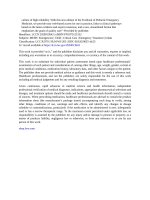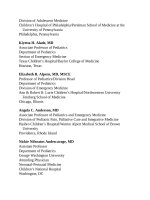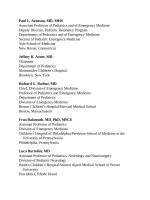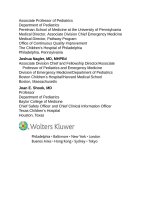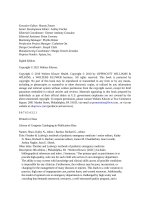Pediatric emergency medicine trisk 1976 1976
Bạn đang xem bản rút gọn của tài liệu. Xem và tải ngay bản đầy đủ của tài liệu tại đây (104.41 KB, 1 trang )
will be more than 200 mSv, with no known measurable biologic effect. Typical
radiation exposures encountered during life and in medicine are listed in Table
90.11 . Children generally have a higher relative risk of cancers (leukemia and
thyroid, skin, breast, and brain cancer) following radiation exposure compared to
adults, likely due to the increased radiosensitivity of their developing organs.
Also, since children are shorter than adults, they may be exposed to radioactive
material deposited on the ground. In addition, their shorter body diameters can
lead to higher-dose exposures to their internal organs.
The hazard posed by a radionuclide depends on its quantity, decay scheme, the
energies of its emissions, its half-life, and length of exposure. For example, a
radionuclide that decays by emitting only alpha particles is not a hazard if kept
outside the body, since alpha particles cannot penetrate even the dead layers of
the skin. However, some radionuclides (e.g., 131Iodine) that are readily absorbed
by the body and/or are concentrated by an organ can be a hazard in small
amounts.
Although the radiation doses to personnel involved in the care of a victim
contaminated by radioactive material are likely to be very small, simple
protective measures should be employed to minimize the doses. There are three
methods of protection from radiation exposure: minimizing time of exposure,
maximizing distance from the material to the extent practical, and using shielding
as appropriate. The amount of exposure received is directly proportional to the
time spent near the source of radiation. Distance is the most practical and
effective method of reducing radiation exposure because the dose decreases by
the square of the distance ( Fig. 90.11 ). This is known as the inverse square law.
The lead aprons used in radiology departments, where the radiation comes from
low-energy, scattered, nonparticulate radiation, are not generally useful in
radiation event management. Lead aprons do not provide effective protection
against the higher-energy radionuclide emissions likely to be encountered with
radioactive contamination.
